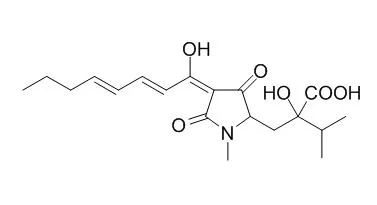| In vitro: |
| J Nat Prod. 2009 Nov;72(11):2032-5. | | Harzianic acid, an antifungal and plant growth promoting metabolite from Trichoderma harzianum.[Pubmed: 19894739] | A Trichoderma harzianum strain, isolated from composted hardwood bark in Western Australia, was found to produce a metabolite with antifungal and plant growth promoting activity.
METHODS AND RESULTS:
The structure and absolute configuration of the fungal compound, Harzianic acid (1), were determined by X-ray diffraction studies. Harzianic acid showed antibiotic activity against Pythium irregulare, Sclerotinia sclerotiorum, and Rhizoctonia solani. A plant growth promotion effect was observed at low concentrations of 1. | | FEMS Microbiol Lett. 2013 Oct;347(2):123-9. | | Harzianic acid: a novel siderophore from Trichoderma harzianum.[Pubmed: 23909277] |
METHODS AND RESULTS:
Agriculture-relevant microorganisms are considered to produce secondary metabolites during processes of competition with other micro- and macro-organisms, symbiosis, parasitism or pathogenesis. Many different strains of the genus Trichoderma, in addition to a direct activity against phytopathogens, are well-known producers of secondary metabolites and compounds that substantially affect the metabolism of the host plant. Harzianic acid is a Trichoderma secondary metabolite, showing antifungal and plant growth promotion activities.
CONCLUSIONS:
This report demonstrates the ability of this tetramic acid to bind with a good affinity essential metals such as Fe(3+) , which may represent a mechanism of iron solubilisation that significantly alters nutrient availability in the soil environment for other microorganisms and the host plant. | | Molecules. 2014 Jul 8;19(7):9760-72. | | A novel fungal metabolite with beneficial properties for agricultural applications.[Pubmed: 25006784] | Harzianic acid (HA) is a T. harzianum metabolite able to promote plant growth and strongly bind iron.
METHODS AND RESULTS:
In this work, we isolated from the culture filtrate of a T. harzianum strain a new metabolite, named isoHarzianic acid (iso-HA), a stereoisomer of Harzianic acid. The structure and absolute configuration of this compound has been determined by spectroscopic methods, including UV-Vis, MS, 1D and 2D NMR analyses. In vitro applications of iso-Harzianic acid inhibited the mycelium radial growth of Sclerotinia sclerotiorum and Rhizoctonia solani. Moreover, iso Harzianic acid improved the germination of tomato seeds and induced disease resistance.
CONCLUSIONS:
HPLC-DAD experiments showed that the production of Harzianic acid and iso Harzianic acid was affected by the presence of plant tissue in the liquid medium. In particular, tomato tissue elicited the production of Harzianic acid but negatively modulated the biosynthesis of its analogue iso-Harzianic acid, suggesting that different forms of the same Trichoderma secondary metabolite have specific roles in the molecular mechanism regulating the Trichoderma plant interaction. |
|






 Cell. 2018 Jan 11;172(1-2):249-261.e12. doi: 10.1016/j.cell.2017.12.019.IF=36.216(2019)
Cell. 2018 Jan 11;172(1-2):249-261.e12. doi: 10.1016/j.cell.2017.12.019.IF=36.216(2019) Cell Metab. 2020 Mar 3;31(3):534-548.e5. doi: 10.1016/j.cmet.2020.01.002.IF=22.415(2019)
Cell Metab. 2020 Mar 3;31(3):534-548.e5. doi: 10.1016/j.cmet.2020.01.002.IF=22.415(2019) Mol Cell. 2017 Nov 16;68(4):673-685.e6. doi: 10.1016/j.molcel.2017.10.022.IF=14.548(2019)
Mol Cell. 2017 Nov 16;68(4):673-685.e6. doi: 10.1016/j.molcel.2017.10.022.IF=14.548(2019)